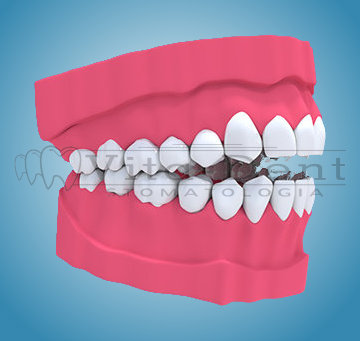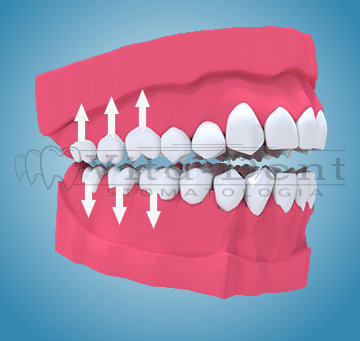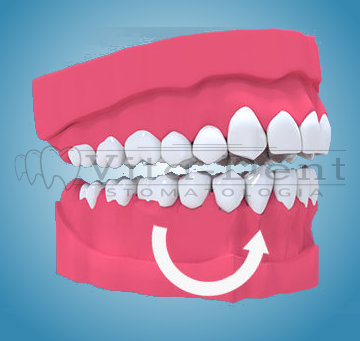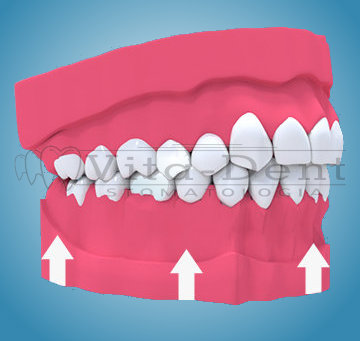Vertical bite defects – Open bite
The open bite is a complex disadvantage, which is primarily associated with the inadequate overlap of the seed teeth. The front part of the tooth is actually the place where the open bite manifests itself most often. However, not always the normal descent of the lower and upper teeth in the occlusion line means the lack of open bite. In most patients, open bites are camouflaged. This means that with development, the body spontaneously leads to a situation where excessive teeth of the front teeth cause masking defects. The result of such action is an unsightly smile, excessively exposed front teeth along with gums.Causes of open bite
An open bite like any orthodontic defect can be caused by genetic or environmental factors. This means that children of patients with "long face syndrome", open bite, excessive exposure of the front teeth, will most likely be affected by a similar defect. An unfavorable inherited growth pattern can be diagnosed as early as the milk toothing stage. In addition to genetic factors, environmental factors play a very important role – such as finger sucking, sowing pacifier, obstruction of the respiratory tract, pushing tongue, infants type of swallowing. The above causes of open bite can to varying degrees exacerbate the defect, but quickly diagnosis can inhibit the progress of abnormalities and restore a harmonious bite. It is believed that irregularities diagnosed before the age of 4 can be corrected on their own, after the elimination of the causative factor.Treatment
The open bite belongs to the disadvantages that are treated most difficult. The primary demarcation that the orthodontist is guided when choosing how to treat each defect is age. In the case of vertical defects, the demarcation shall be as follows:Patients at an early stage of development
Patients up to the stage of late milk toothing are usually treated by eliminating environmental factors causing the bite to open. For factors such as finger sucking or incorrect language pushing, a firewall for the language is mostly used, which in a short time perfectly eliminates unfavorable habits. If bad finger sucking habits occur only at night, mechanical locking of the hand with pajamas may be helpful.Patients during development
This group consists primarily of patients in the course of replacing the period on milk permanently and with early constant teeth. Also in this group there may be bad habits that can be eliminated by exercise and various types of mobile cameras. In addition, bite treatment in patients with adverse growth patterns can be carried out using:- extraoral apparatus types of headgear,
- biting rails,
- and linguistic arcs.
Adult patients
This group can be treated actively by affecting the shaped teeth. Both the restoration of functions and aesthetics should be considered when making decisions. Treatment by extrusion (excessive teeth) of the front teeth often leads to an aesthetically unfavorable exposure of the sieve teeth both in smile and at rest. Another method of treatment is the intruding (pressing) of the stem teeth, which causes the bite to be closed on the principle of wedge action. The above action favorably affects the patient's profile, as the mandibular moves forward and up (counterclockwise) – which emphasizes the chin, improving the aesthetics of the profile. Treatment regimen available on the side (Fig. 1 – Bite open front – treatment)

Bite open before treatment

Bite open intruder of lateral teeth

Open bite – anteriorotation

Bite open after treatment
Vertical orthodontic defects – Frequently asked questions:

- At what age should I go for the first orthodontic consultation? A follow-up visit, during which the orthodontist is able to assess the position of milk teeth, can be carried out at the age of 3.5 – 4 years. This visit is used to identify unfavorable habits such as finger/pacifier sucking, unfavorable pushing of the tongue, tongue hypertrophy, breathing through the mouth. The assessment of the above factors will eliminate the effects of adverse habits and restore the right direction of dental development.
- When is it known that a child can develop an open bite? The assessment of tooth and bone development is best monitored regularly from the age of full milk dentition. At the age of 5-6, the first preliminary signs of the development of teeth and bones towards the open bite can already be seen. If adverse features are observed, the doctor often recommends taking measures to correct vertical growth. This correction, in the case of open bites, is usually intended to inhibit excessive teeth.
